Clark's Sphinx Moth
Unriddle the Clark's Sphinx Moth!
Interested in a moth? Look no further! After exploring our website,
you will be an expert on the Clark Sphinx Moth and all of its
incredible
attributes!
It is amazing that this moth gets its
scientific name from not only Greek mythology (Persephone), but also William Clark
from the Lewis and Clark Expedition. This page will be much more than a learning
experience, more like an expedition. Looking through our
website, you will find information regarding
classification,
habitat and geography,
form and function,
nutrition,
life history and reproduction,
interactions, and
fun facts about the Proserpinus clarkiae!

What is some general information before starting your expedition?
What it looks like of course. The wingspan of this moth is from
3-3.8 centimeters and is considered a medium-sized moth
(Butterflies and Moths of North America 2014 and Macromoths of
Northwest Forests and Woodlands 2013).
Proserpinus clarkiae adults are green colored with pale green
dorsolateral lines and have orange colored
forewings with a black border. If you are planning to spot or research this
beautiful rare organism, the best time would be from spring to early
summer.
To find out more about where the Clark's Sphinx Moth is
located, head to the habitat and geography
page! Otherwise, continue onto the
classification page.
Check out some more organisms at
Multipleorganisms.net!
Header picture used with permission by
Marcel Holyoak of the Clark's Sphinx Moth. Check out some more of
his pictures of other organisms
here!
